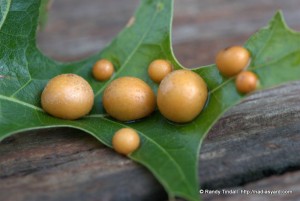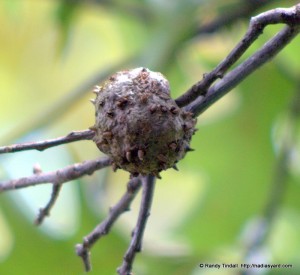(NOTE: Full confession—I goofed! The following article is partially incorrect. The apple-like galls are NOT caused by one of the generations of a cynipid wasp, but rather by Polystepha pilulae, a midge, a mere dipteran, not a noble hymenopteran. The wasp does indeed cause the the horned oak galls found on twigs, but the juicy version found on leaves is an elongated gall running along the leaf veins. This is discussed in a later post.)
Also, by the way, the title is a vague reference to Arlo Guthrie’s “Alice’s Restaurant”. Those of you who grew up in the 60’s and 70’s will recognize it. Others may not. That’s okay.
————————————————————————————–
Nothing’s ever perfect. Not in our backyard. Not in yours, I bet.
At least that’s one way of looking at it. Another way might be just to accept that “perfection” in nature is pretty much just something we try to impose on our world. Some of us believe that a perfect yard is a uniform green carpet, lush and friendly to bare feet. Some of us prefer a little more chaos and complexity in our surroundings.
Take our backyard Pin Oak, for instance. It’s a pretty enough tree in its own right, named for the needle-sharp tips on its leaf lobes. It grows high and shady and keeps a lot of early sun off our house during the dog days—a much appreciated quality in recent years. It’s a great climbing tree, something I have explored on many occasions, much to Nadia’s consternation, using the excuse of getting up there and trimming off dead branches. You can take those conveniently spaced limbs all the way to the top, although I haven’t made it that far. Yet. Twenty feet or so up, I generally hear something like “Aiiieeee!! You’re going to fall and break yourself!”, and I reverse course. Someday, though. It’s on my bucket list.
But I digress.
Recently we’ve been seeing a lot of this:
These are oak leaf galls, which my limited research is telling me are caused by a tiny cynipid wasp, which won’t sting you or me, but can certainly mess up the complexion of a pin oak. Not just our oak. All up and down the street we can see leafy twigs full of little apple-like structures, which in turn, I hear are full of little wasp larvae. These larvae will emerge to search for love and destiny, and if they succeed in at least one of these goals the females will lay their eggs on the woody stems of a tree. By next spring, these will result in another type of gall, adding insult to injury.
After a suitable period of time, two years or more, wasps emerge from these spiny warts to lay more eggs on the veins of the leaves, and we’re off to the races again. In my opinion, the oak tree gets the worst end of this deal, but it doesn’t seem to mind much. The wasps, on the other hand, get food and shelter and a chance to annoy people who find twig and leaf blemishes to be “imperfections” and eyesores.
Heavy infestations can drain the resources of the host tree, but there doesn’t seem to be much anyone can do about it anyway, since there apparently is no recommended chemical solution. If you are really serious about wanting your trees looking picture-perfect, you can cut off infected twigs and destroy the galls, but I suspect this is mainly useful as a good excuse to climb an oak tree (Aiiiieee!!!). You’ll never get ’em all, but it would be good fun trying.
However, I have never come close to achieving perfection and so have become highly tolerant of its lack in other things. We will live and let live, as far as our gall crop is concerned. Why be hypocritical, after all? There are thousands of “galls” in our fair city, blemishes upon a once pristine prairie. We refinanced ours a couple of years ago and are rather fond of it. We may never emerge.



I’m hoping you can help as I have 3 very large pin oaks that have the same ” a lot of dam galls”. 1 tree +/- 50 foot tall has a few, but the other 2 trees, 35 foot tall, have leaf galls very bad. So bad that the limbs are hanging down, appear to be overloading, and the trees look wacky. Help?
My understanding is that these galls don’t really bother the tree all that much. Our pin oak is heavily infested with galls this year. It’s looking pretty droopy, too, but then we’ve had an extreme drought this summer. I blame the drought.
Controlling the galls seems to require spraying pesticides, but they don’t seem to be very effective. I’d suggest just letting nature take its course. And water that tree for a few hours a week.
Thanks for your comment!